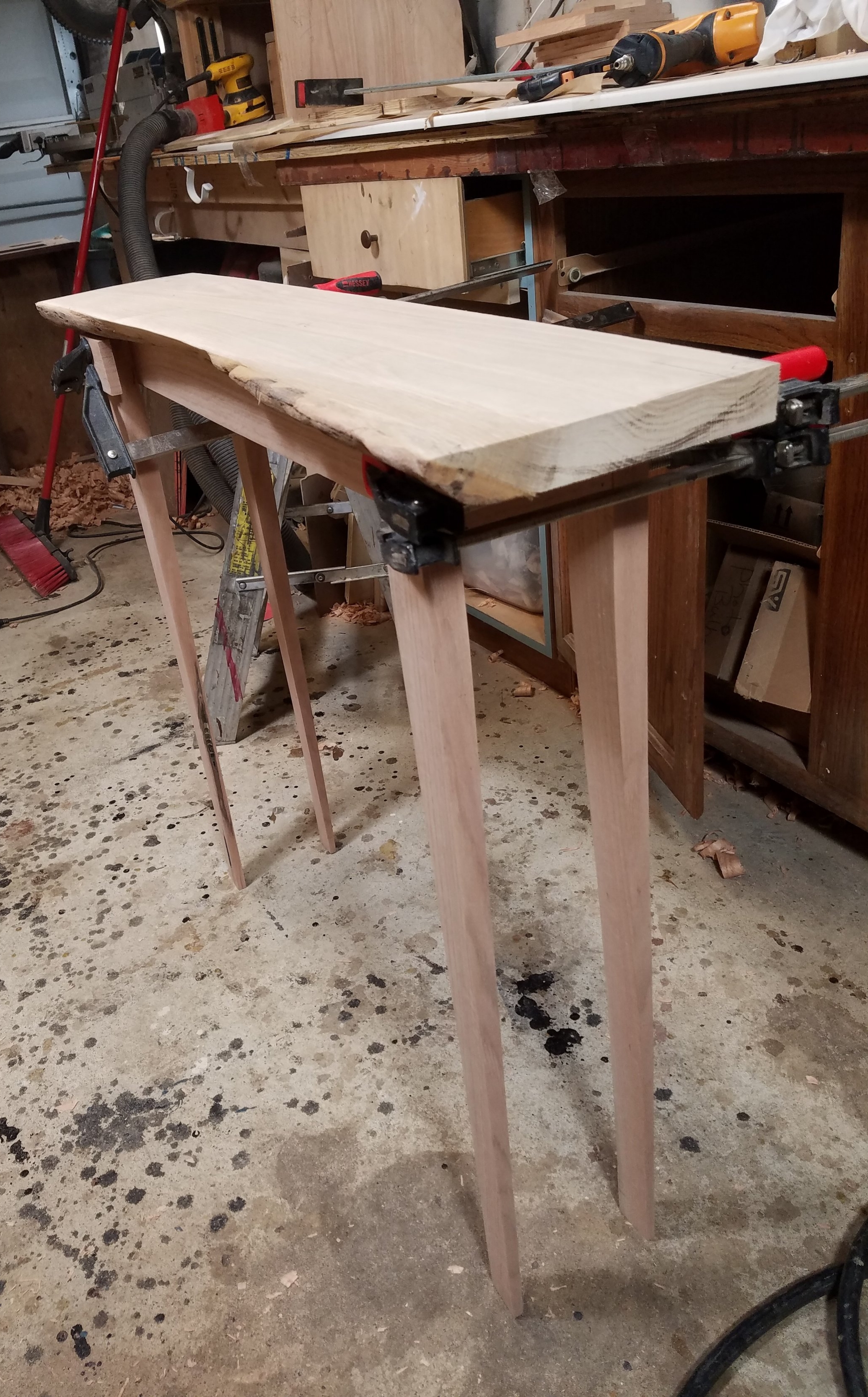Slab To Hall Table Project Part 1
One night while browsing Craigslist, I found a source for timber harvested from the local Tidewater region of Virginia. After contacting this individual and arriving to his house, I was not certain what I was getting myself into. As such Craigslist adventures go, you never know what you are going to run into. What I ran into, was neatly stacked slabs of dried lumber. I was shown poplar, quartersawn red oak, white oak, hickory, and beautiful slabs of burl black walnut. I decided to pick up a white oak slab and some board feet of quarter sawn red oak.
I was thrilled to learn after some conversation that this lumber was harvested from an area behind Bayside Hospital in Virginia Beach. I had no idea that this option existed in this area. I was thrilled to have access to such timber. I loaded up my lumber and transported it to the shop. As I stacked the boards in a careful manner to prevent any cupping or twisting, I began to wonder what should be created from this wood. Perhaps some boxes, some picture frames, some hanging bottle openers? I knew I had plenty of options, and will probably make all of the above eventually!
Sitting in the shop admiring my first slab, I began to imagine the life and history that this tree was part of. Who breathed the oxygen from its leaves. Who walked by and lived among these two beautiful trees that resided near where the Pungo Witch Trial took place. I smiled as I envision a live edge table made from the white oak slab and supported by quartersawn red oak apron and legs, What better way to honor these treasures of the earth, than a beautiful table that could fit in someone's hallway or behind their couch.
Transforming The Slab To A Table Top
I was eager to get started planing the slab to a flat surface. I recently received some Japanese hand planes I ordered on Amazon. I clamped the slab to the bench, adjusted the plane blades. I did this by tapping the blade to lower it or tapping the back of the plane to pull it back up. Once I was dialed in, I set to work scraping paper thin layers of the slab. This was very labor intensive, and soon my floor was covered in beautiful shavings.. There is something meditative when using hand tools. I felt as though the wood and I became well acquainted. Soon Both sides were roughly planed. I figure a random orbit sander will assist with the rest of the milling.
I have no experience with wood slabs which are basically wood with bark still on it. I wanted to preserve as much of the naturalness of the tree as possible; however, it is important that the piece feel good to the touch. No rough edges or sharp bark to give splinters when running your hand along the edge. On one side, the bark section of the tree came right off in one piece. For the other side, a sharp chisel was used to remove loose material, and gently shape the edge.
I discovered just how live edge this slab was. A family of ants had taken residence in a small section on the bottom of the slab. This caused a bit of a chuckle of course. I knew that this would not be able to be used in the table, so it was separated from the healthy portion using a Japanese razor saw. Perhaps this section would make a great sign one day.
I reached a design fork in the road as I needed to decide which edge was the front, and whether both sides should be live edge. I decided to square the back and sides, as this would allow the table to sit close to a wall or a couch. So with the use of a metal straight edge clamped to the wood, and my noisey circular saw, the back edge was cut. Since the edge was not symmetrical, I had to cut at a slight angle. This allowed for the final piece to be more aesthetically pleasing.



Building The Apron & Legs
It was time to move on to the apron and the legs. I set the slab aside and grabbed one of the rough lengths of the quartersawn red oak. I knew some work was in store for me, as the pieces were not straight and still had the rough cut from the sawmill. I estimated I could cut rough lengths using the miter saw for bot the apron and the legs. The apron could be made by re-sawing the lumber in half. For the legs, the golden mean was used based on the thickness of the wood. This yielded a rectangle with perfect length to width proportions, and the length of the legs.
Using the table saw and miter saw, the stock was cleaned up to produce wood with 6 squared sides. The apron pieces were hand planed, and chopped up to be dry fitted. For the legs, I knew that something had to be done to create some elegance. Using my now favorite handplanes, wood from the inside and back was removed. This created a slight taper , allowing a more pleasing shape to the eye. Material was left on the top of the legs to to ensure proper joining to the table. A slight bevel was used on the edges of the legs to make them feel better to the touch. The hand plane was also used to remove some material from the middle of the front apron. This created a slight, almost undetectable, change to the profile. I believe these two minor details, do wonders for the overall design of the table.
I dry fitted the pieces together to ensure everything worked. A success. Time to Sand. I hit all the pieces with the random orbiting sander with 80 grit sandpaper and progressed to 220 grit. This produced a smooth as glass surface. Using various clamps and a brad nailer, the pieces were assembled with gorilla glue. Careful attention was given to ensure the assembly surface was flat and level. This was left overnight to dry.
Well this concludes Part 1 of the Slab To Hall Table Project. This was an adventure to build. There is a feeling that occurs, it is hard to explain, when working with rough raw lumber. In order to tease the essence of the wood out, you must introduce yourself so you can get to know one another. A handplane, saw, and sand paper are the conversation towards a balance of natural beauty, and a visually pleasing design.
Stay tuned as Part 2 will be coming soon! In Part 2, we complete the table by sanding some more and applying the finish. I am thinking tung oil and sprayed lacquer. Maybe if I am feeling crazy, an attempt at shellac with a french polished table top could occur. You never know whats going to happen in the SugarTree WoodWerks shop!!!
















